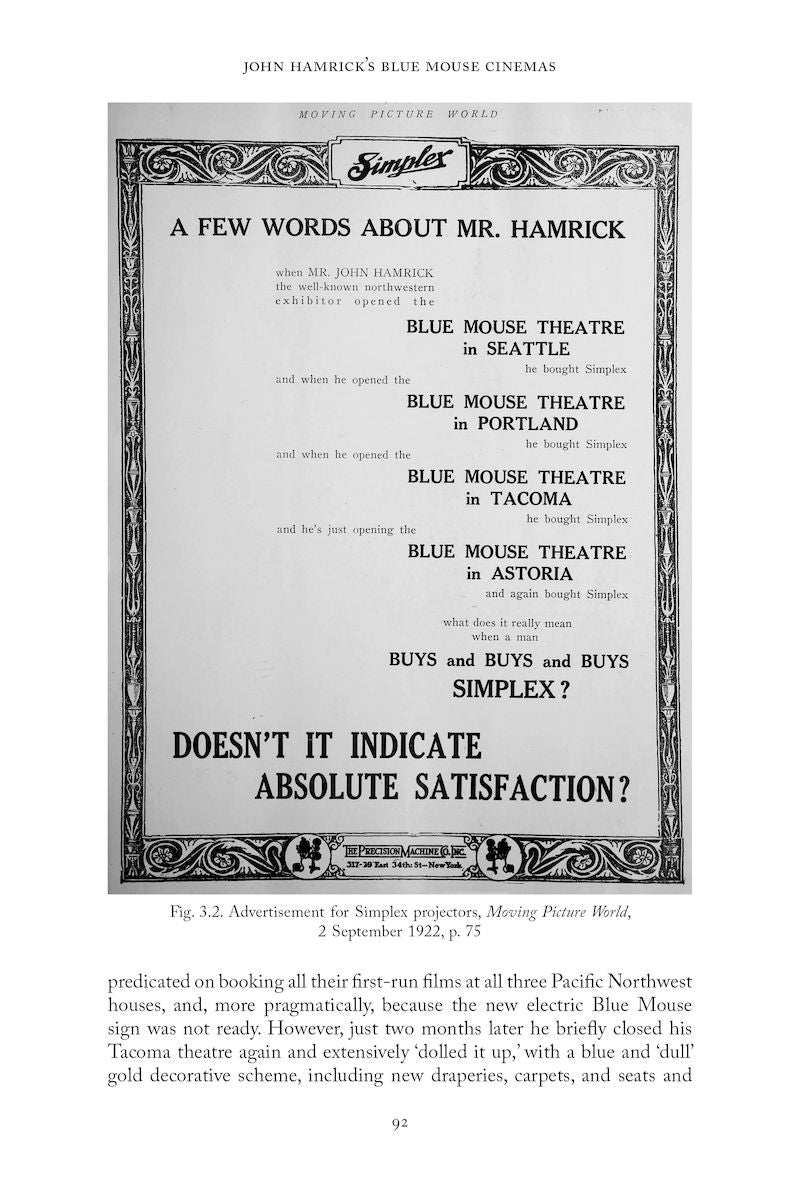University of Exeter Press
John Hamrick’s Blue Mouse Cinemas
Independent Exhibition and Influence in the Studio Era
Couldn't load pickup availability











- 238 Pages
John Hamrick's Blue Mouse Cinemas offers a unique, in-depth case study of regional independent film exhibition in the American Pacific Northwest. Focusing on the silent and early sound periods, this book provides important evidence of the ways an independent entrepreneur, John Hamrick—a charismatic if highly flawed theatre-owner and card-carrying Klansman—could influence Hollywood film culture, as well as exhibition and distribution patterns both within and beyond his region of operation.
The Blue Mouse(s) were a set of charmingly same-named theatres that, beginning in 1920, Hamrick built, opened, and operated across the Pacific Northwest: in Seattle, Tacoma, Portland, and Astoria. In addition to the Mouses, Hamrick would at various times own, in full or in partnership, dozens of other movie houses across Oregon, Washington, and Idaho. But the Mouses were always his marquee theatres, and ultimately those most closely associated with his theatrical persona, both regionally and within the wider industry.
This book helps us understand the unexplored role and influence of American indie small-chain exhibitors as they continually balanced local and national interests in the name of profitably providing entertainment. The Blue Mouse theatres were part of a well-networked commercial web working across this previously unstudied region. By considering this phenomenon, we can begin to more fully grasp the limits and possibilities of independent exhibition at the height of the studio era, and how the multivalent forces of regionalism intersected with the wider film industry.
Michael Aronson’s engagingly written history transports us to the rapidly urbanizing Pacific Northwest of the 1920s, where entrepreneurial film exhibitor John Hamrick built a circuit of movie theaters. This richly detailed study charts Hamrick’s economic, technological and cultural maneuvers during times of tumultuous change. Aronson’s analysis models a regional approach to moviegoing history, and positions us to consider how continual changes will impact the future of independent theaters.
Kathy Fuller-Seeley, William P. Hobby Centennial Professor of Media History, University of Texas
John Hamrick's Blue Mouse Cinemas is as engaging to read as it is accomplished in its historical research. By meticulously tracking and convincingly contextualizing the life and business practices of a single independent exhibitor/showman, Michael Aronson makes an invaluable contribution to our understanding of American commercial cinema in the 1920s, ranging over the KKK and Vitaphone, distribution practices and exhibition strategies, all while bringing the idea of region directly to the fore.
Gregory Waller, Provost Professor of Cinema and Media Studies, Indiana University
A landmark volume. In a book that weaves together infographics, archival records, and compelling prose, Michael Aronson has expanded the map for studies of movie exhibition. His analysis of Hamrick—a savvy and unsavory entrepreneur—presents a fascinating case study with broad implications for U.S. film history.
Eric Hoyt, Kahl Family Professor of Film, Media and Cultural Studies, University of Wisconsin-Madison
A riveting account of John Hamrick’s (life and) career as a key film exhibitor leads us into an important analysis of regional film (exhibition) history and new questions about what it means to be independent from and yet interdependent on the Hollywood system. Aronson has delivered a must read for anyone studying regional film history, film exhibition, and the history of the Pacific Northwest.
Prof. Ross Melnick, Department of Film and Media Studies, University of California
Introduction: Mouse
1. Seattle: Mouse Moves House
2. Pacific Northwest: Klan Mouse
3. Tacoma: City Mouse, Suburban Mouse
4. Astoria: Failure Mouse, Trial by Fire
5. Portland: Sync Sound Mouse
Afterword: Three Decades Long
Notes
Select Bibliography
Index


































